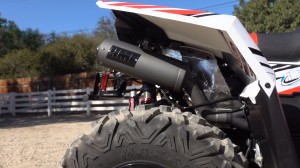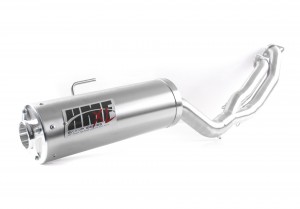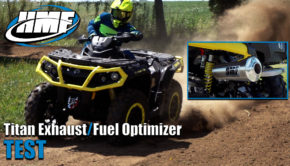HMF Scrambler XP 1000 and 850 Titan Series Exhaust and Fuel Optimizer Test:
If you own a Polaris Scrambler XP 1000, chances are that you’re a believer that too much power is never enough. Maybe you’ve owned your Scrambler 850 for a while and are ready for a boost in performance. We recently had the chance to spend a day testing a Scrambler XP 1000 project built by Teixeira Tech. The XP was outfitted with an HMF Titan-Quiet exhaust, Fuel Optimizer, and Uni air-filter, all of which are available through HMF. These three items are almost always the starting point for adding horsepower, and HMF has proven to build power on a number of 4×4 and sport ATVs we’ve built up in the past. With this in mind, we decided to take a closer look at what HMF has to offer for the Scrambler.

HMF’s Titan-Quiet exhaust system is claimed to add only 1-2dB of sound. The Titan converts the 1000’s exhaust from a dual silencer to a two-into-one system, reducing weight from just over 24lbs down to around 12.5 pounds, a healthy weight savings.
Power up
HMF’s Titan-Quiet exhaust system is claimed to add only 1-2dB of sound. For those who really like to be heard, HMF also offers the Titan-XL, or extra loud exhaust, claimed to produce 4-6dB more than stock. Both are available as a full system only. The XL system uses a dual stage core in the silencer, while the Quiet system uses a multi-chamber core for better sound suppression. Not a one size fits all exhaust, HMF uses a 1 ½” head pipe leading up to the collector on the Scrambler 850 and a 1 ¾” pipe on the 1000 to optimize performance for each engine. HMF offers a snorkel for the Titan, making it the perfect exhaust for those building a machine to conquer deep mud.

The Titan is constructed of stainless steel throughout with the exception of its billet aluminum end cap. The Titan is available in a brushed stainless steel finish or can be blacked out,
The Titan is constructed of stainless steel throughout with the exception of its billet aluminum end cap. The Titan is available in a brushed stainless steel finish or can be blacked out, with a matt black ceramic coating formulated to withstand extreme temperatures.
The Titan converts the 1000’s exhaust from a dual silencer to a two-into-one system, reducing cost and cutting the exhaust’s weight from just over 24lbs down to around 12.5 pounds, a healthy weight savings.

A Uni foam air-filter flows better than the stock paper filter, adding horsepower while still filtering small dust particles better than cotton style filters, making a Uni perfect for dusty GNCC conditions.
A Uni foam air-filter flows better than the stock paper filter, adding horsepower while still filtering small dust particles better than cotton style filters, making a Uni perfect for dusty GNCC conditions. It can be cleaned thoroughly and will work as good as new. Polaris stock paper filters need to be replaced pretty regularly and are a little pricy.

HMF’s Optimizer provides plug and play installation along with convenient on-board, push button tuning. Paired with the Titan-Quiet exhaust and Uni filter, the Optimizer’s stock map had the Scrambler running flawlessly.
The Titan exhaust and UNI filter demand the use of an aftermarket fuel module like HMF’s Fuel Optimizer to match fuel requirements with the increased airflow. HMF’s Optimizer provides plug and play installation along with convenient on-board, push button tuning. It allows you to independently tune from 0-1/4 throttle, 1/4-3/4 throttle, and 3/4- full throttle; it’s similar to switching the pilot, needle, and main jet on a carburetor. You can also tune the rate at which one fuel setting transfers onto the next, similar to using different taper needles in a carburetor. There is also a setting that lets you fine-tune the amount of fuel added when you crack the throttle right off idle, helping tune out off-idle hesitation. If this all sounds intimidating, don’t let it. HMF provides easy to understand print and online video instructions on tuning. The Optimizer’s only drawback is that its range of adjustability is more limited than that of a fuel manager that’s tuned with a laptop computer. If you are looking to build a high-compression, big-cam, ported engine, you’ll need to send the controller to Dobeck and have its internal baseline fuel settings increased. Compensating for external motor mods, it’s good to go.
The Test
We’ve had to fine tune HMF’s Optimizer a bit on some other models, which we found simple and intuitive after reading the instructions. Paired with the Titan-Quiet exhaust and Uni filter, the Optimizer’s stock map had the Scrambler running flawlessly with no tuning needed. To the ear, the HMF system seems a bit less noisy than stock. The stock exhaust is a bit hollow and tinny sounding compared to the deeper and slightly punchier HMF. The Titan definitely has a more pleasant sound.
Flowing better from the intake to the exhaust, throttle response was crisp and clean. On the trail, there’s a small, but notable, boost in performance across the RPM range while retaining very smooth, linear power delivery. It pulled a little harder off the line and out of corners. The best gains in power came in the midrange, boosting acceleration and responsiveness slightly at higher speeds. This allows the engine to power up long hills with even greater ease and adds to your ability to lighten, or raise, the front wheels for bumps that approach at a rather fast pace on a Scrambler XP1K.

The Titan Exhaust and Fuel Optimizer let the Scrambler pull a little harder off the line and out of corners. The best gains in power came in the midrange, boosting acceleration and responsiveness slightly at higher speeds.
Conclusions
Stainless steel construction makes the Titan exhaust corrosion resistant and its build quality appears to be very good. We were reluctant to try the Blackout finish; however, we are happy to report that it’s holding up well to flying debris and is doing a superb job of resisting heat discoloration, even on the head pipes.
Power gains with an aftermarket exhaust are dependent on the quality of the pipe manufacturer, the engine, and the design of the stock exhaust system it’s replacing. On some machines, the difference in performance between HMF’s Titan-Quiet and Titan-XL is so small that we couldn’t justify going with the louder system and were very happy with the results. The Titan-Quiet seemed to boost performance on the Scrambler 1000, but the gains weren’t quite as dramatic as on some other less-powerful machines we’ve tested the Titan-Quiet with.
HMF’s tells us that the Scrambler 850 and 1000 gain about twice the power with the Titan XL as with the Titan Quiet. With its optional snorkel, the Titan exhaust is a no-brainer for building a mud machine. For us, choosing between the Quiet and XL version would simply come down to where we intended to ride. In noise sensitive areas, we would have to opt for the Titan-Quiet. If we were planning on racing or riding in areas where noise is not an issue, we’d deal with a few extra debacles of sound and opt for the Titan-XL to get the most bang for the buck.
HMF Scrambler Titan Exhaust and Fuel Optimizer Rating
Summary: HMF’s tells us that the Scrambler 850 and 1000 gain about twice the power with the Titan XL as with the Titan Quiet. With its optional snorkel, the Titan exhaust is a no-brainer for building a mud machine. For us, choosing between the Quiet and XL version would simply come down to where we intended to ride. In noise sensitive areas, we would have to opt for the Titan-Quiet. If we were planning on racing or riding in areas where noise is not an issue, we’d deal with a few extra debacles of sound and opt for the Titan-XL to get the most bang for the buck.












